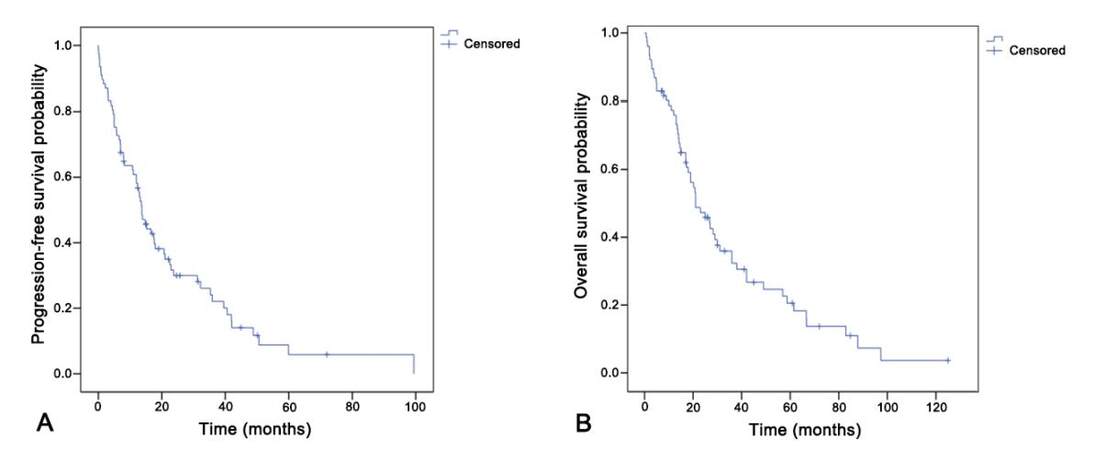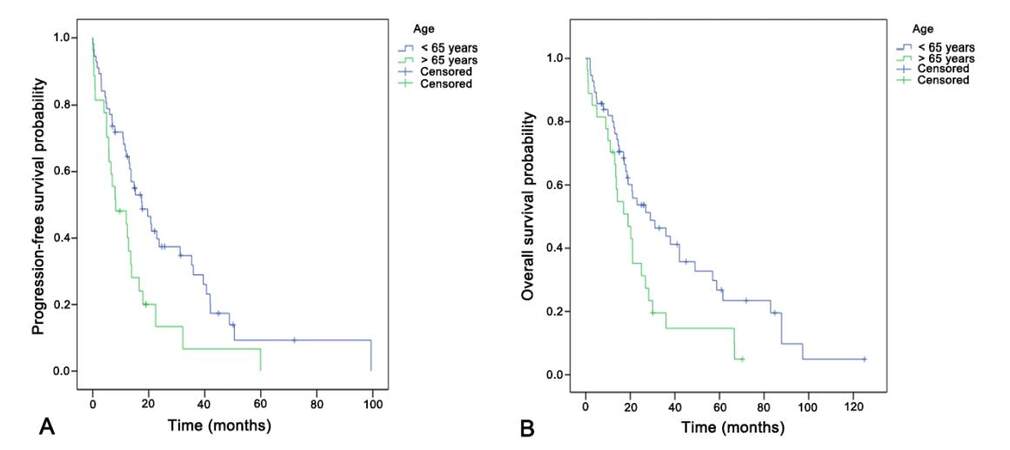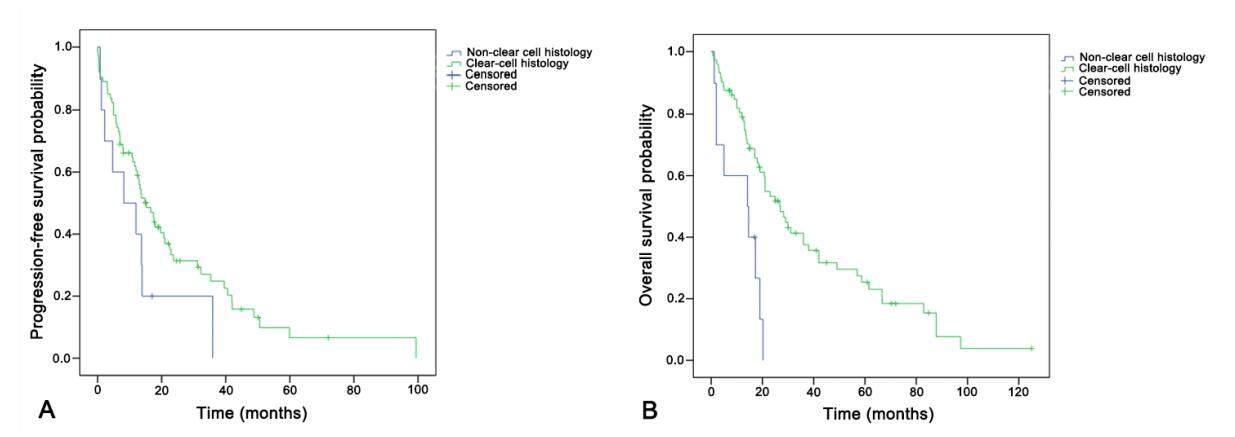Sunitinib effectiveness and safety as first line treatment in metastatic renal cell carcinoma, in the Costa Rican population
Abstract
Aim: Tyrosine kinase inhibitors are part of the armamentarium to treat metastatic renal cell carcinomas (mRCC). Costa Rica has approved sunitinib in the first line setting. The authors conducted a retrospective study to address the effectiveness and safety profile of sunitinib in our population in terms of overall survival (OS) and progression free survival (PFS).
Methods: The authors analyzed all patients who were treated with sunitinib diagnosed with mRCC in the three National Hospitals (Hospital Mexico, Hospital San Juan de Dios, and Hospital Calderon Guardia) from February 2007 to June 2015. Demographics, safety profile, and efficacy (OS and PFS) were obtained from medical records. OS and PFS were calculated using the Kaplan Meier method and a Cox Proportional Model Analysis was used when OS and PFS were compared in subset of patients.
Results: Seventy-seven patients were included; mean age was 58.9 years. Fifty-four patients were male (70.1%). The most common histologic type was clear cell carcinoma (87%), followed by papillary (9.1%) and chromophobe (2.0%) types. Median OS was 21.0 months [95% confidence interval (CI): 13.42-28.58]. Median PFS was 13.7 months (95% CI: 11.24-16.16). Patients aged 65 years or older experienced worse PFS and OS than younger patients (median PFS: 8.2 vs. 17.6 months; P = 0.011) (median OS: 19.0 vs. 29.0 months; P = 0.022). Sunitinib was well tolerated and no serious side effects were reported.
Conclusion: This is the first study in Central America showing that sunitinib, first line, in mRCC is as effective as reported in pivotal clinical trials and expanded use studies in terms of PFS and OS.
Keywords
Introduction
Renal cell carcinoma (RCC) accounts for about 3% of all adult cancers, is the 8th most common cancer in Central America and the 10th worldwide, and the clear-cell RCC (ccRCC) is its most frequent histologic subtype.[1-4]
Surgery remains the standard of care for localized disease, and can often be curative.[5,6] Unfortunately, metastatic RCC (mRCC) is found in approximately one third of patients.[7] Furthermore, RCC is extremely resistant to conventional chemotherapy.[8] That is why different treatment strategies had been developed, taking into account improvements in understanding RCC biology and tumor behavior. RCC is highly vascularized due to overexpression of vascular endothelial growth factor (VEGF) induced by alterations of the tumor suppressor gene, Von Hippel-Lindau (VHL), leading to the increase of hypoxia-inducible factors 1 alpha and 2 alpha, ending in angiogenesis.[9] This has allowed the development of VEGF inhibitors such as tyrosine-kinase inhibitors (TKIs), monoclonal antibodies against VEGF, and mammalian target of rapamycin (mTOR) inhibitors.[5]
In Costa Rica the National Health Care System (Caja Costarricense de Seguro Social, CCSS) has authorized the use of sunitinib to treat mRCC in first line setting.[10] Sunitinib is a multiple TKI, including the VEFG receptors (VEFGRs) and platelet-derived growth factor receptors, producing a strong antitumor action in mRCC[11] and is approved worldwide as upfront line treatment of mRCC, with the reporting of significant objective response rates and also superiority over interferon-alfa in progression-free survival (PFS), with a trend to increase overall survival (OS).[12,13]
In this retrospective study we evaluated the effectiveness of sunitinib in the Costa Rican population in terms of median overall survival (mOS), median progression free survival (mPFS) and its safety profile.
Methods
Patients and study design
This is a retrospective study reviewing the medical records from a total of 77 patients treated with sunitinib as first-line therapy in mRCC. Data were collected between February 2007 and June 2015 in the three major hospitals (Hospital San Juan de Dios, Hospital Calderon Guardia and Hospital Mexico) in San Jose, Costa Rica. All patients were required to be at least 18 years of age and to have histologically confirmed mRCC (regardless of histologic subtype). The Ethics Committees in each hospital approved this study. All patients received oral sunitinib maleate, 50 mg once daily for 4 weeks of a 6-week treatment cycle (4 weeks on, 2 weeks off). The dosage was reduced in some cases to 37.5 mg daily. Sunitinib was given until disease progression or unacceptable toxicity. Physical examination and clinical laboratory tests were performed approximately one or two days before each cycle. Adverse events were registered according to the National Cancer Institute (NCI) common terminology Criteria for Adverse Events (CTACAE), version 3.0. Tumor evaluation was performed according to Response Evaluation Criteria in Solid Tumors (RECIST) version 1.0, this assessment being done in accordance with local practices at each hospital. PFS was defined as from time of starting sunitinib to disease progression or death from any cause (death could occur within one month of the last treatment dose and was included in the PFS analysis). OS was defined as the time from start of sunitinib to death from any cause.
Statistical analysis
In this retrospective study we included all patients who received sunitinib during the observational period of time in Costa Rica. For that reason there were neither pre-specified sample sizes nor pre-established hypotheses to evaluate. Categorical variables are presented as percentages. Continuous variables are presented as the mean ± standard deviation. To assess the PFS and OS the Kaplan-Meier method was used. A Cox Proportional Model Analysis was employed to determine differences in the outcome variables according to age less or higher than 65 year. In addition univariate and multivariate analyses were used to explore the association between OS and PFS with prognostic factors. A P value less than 0.05 was considered statistically significant. Data were analyzed using SPSS for Mac version 20.0 (SPSS, Chicago, IL).
Results
A total of 77 patients were included in the study. Patient characteristics are described in Table 1. All patients received sunitinib as first line treatment, while none was previously treated either with cytokines or TKIs. With a median follow-up of 18.9 months, mPFS was 13.7 months [95% confidence interval (CI): 11.24-16.16 months], and mOS was 21.0 months (95% CI: 13.42-28.58 months) [Figure 1].
Patient characteristics
| All patients (n = 77) | |
|---|---|
| Median age (years, range) | 58.9 (47.4-70.4) |
| Patients older than 65 years (%) | 25 (32.4) |
| Gender (%) | |
| Female | 23 (29.9) |
| Male | 54 (70.1) |
| ECOG/PS (%) | |
| 0 | 60 (77.9) |
| 1 | 10 (12.9) |
| 2 | 7 (9.2) |
| Histological variant (%) | |
| Clear cell carcinoma | 67 (87.0) |
| Papillary | 7 (9.1) |
| Chromophobe | 2 (2.6) |
| Collecting duct carcinoma | 1 (1.3) |
| MSKCC risk classification (%) | |
| Low | 47 (61.0) |
| Intermediate | 25 (32.4) |
| High | 5 (6.5) |
| Site of metastasis (%) | |
| Lung | 55 (52.8) |
| Bone | 19 (18.3) |
| Liver | 16 (15.3) |
| Central nervous system | 10 (9.6) |
| Other | 4 (3.8) |
Figure 1. (A) Probability of progression-free survival in all patients: 13.7 months (95% CI: 11.24-16.16 months); (B) probability of overall survival in all patients: 21.0 months (95% CI: 13.42-28.58 months). CI: confidence interval
A statistically significant difference was found in terms of PFS and OS according to patient age, risk of progression as well as risk of death by disease. This was higher in patients 65 years or older in comparison to those with less than 65 years. mPFS was 17.6 months (95% CI: 10.2-25.0 months) vs. 8.2 months (95% CI: 0.1-16.4 months); hazard ratio (HR): 1.93 (95% CI: 1.2-3.2); P = 0.011; mOS was 29.0 months (95% CI: 11.4-46.5) vs. 19.0 months (95% CI: 11.0-26.9, HR = 1.82; 95% CI = 1.1-3.1); P = 0.022 [Figure 2]. These findings were confirmed in univariate and multivariate analyses [Tables 3 and 4], showing that age was an independent prognostic factor either for PFS or OS.
Figure 2. (A) Probability of progression-free survival according to age: less than 65 years: 17.6 months (95% CI: 10.2-25.0) and 8.2 months (95% CI: 0.1-16.4) in patients older than 65 years. HR = 1.93 (95% CI: 1.2-3.2); P = 0.011; (B) probability of overall survival according to age, 29.0 months (less than 65 years) (95% CI: 11.4-46.5) vs. 19.0 months (older than 65 years) (95% CI: 11.0-26.9) (HR = 1.82; 95% CI: 1.1-3.1); P = 0.022. CI: confidence interval; HR: hazard ratio
There was no difference in PFS by gender or histological variant [Table 2]. However, a significant difference was found in mOS according to histological subtype in favor of ccRCC when compared with non-clear cell carcinoma: 26.8 months (95% CI: 20.1-30.5) vs. 14.2 months (95% CI: 0-29.0); HR: 3.41 (95% CI: 1.6-7.3; P = 0.001) [Figure 3]. When univariate and multivariate analyses were performed, it was found that ccRCC was an independent prognostic factor in terms of OS but not PFS [Tables 3 and 4].
Progression-free survival and overall survival by gender and histological variant
| mPFS | mOS | ||
|---|---|---|---|
| Gender | Female | 10.8 months (95% CI: 3.1-18.5) | 18.0 months (95% CI: 13.2-22.8) |
| Male | 15.2 months (95% CI: 10.9-19.5) | 23.0 months (95% CI: 16.2-29.7) | |
| (HR:1.21; 95% CI: 0.71-2.0; P = 0.49) | (HR: 1.23 95% CI: 0.71-2.11; P = 0.46) | ||
| Histology | Clear cell carcinoma | 15.2 months (95% CI: 10.8-19.7) | 26.8 months (95% CI: 20.1-30.5) |
| Non-clear cell carcinoma | 8.2 months (95% CI: 0-19.5) | 14.2 months (95% CI: 0-29.0) | |
| HR: 1.84 (95% CI: 0.9-3.76); P = 0.089 | HR: 3.41 (95% CI: 1.6-7.3); P = 0.001) |
Figure 3. (A) Probability of progression-free survival according to histology. Median PFS: 15.2 months (clear cell histology) vs. 8.2 months (non-clear cell histology) HR = 1.84 (95% CI: 0.9-3.76); P = 0.089; (B) probability of overall survival according to histology: 26.8 months (clear cell histology) (95% CI: 20.1-30.5) vs. 14.2 months (non-clear cell histology) (95% CI: 0-29.0) HR = 3.41 (95% CI: 1.6-7.3; P = 0.001). PFS: progression-free survival; CI: confidence interval; HR: hazard ratio
Univariate and multivariate analyses of potential prognostic variables for overall survival
| Variable | Univariate hazard ratio (95% CI) | P value | Multivariate hazard ratio (95% CI) | P value |
|---|---|---|---|---|
| Male sex | 0.77 (0.44-1.36) | 0.372 | 0.88 (0.49-1.55) | 0.659 |
| Clear cell histology | 0.29 (0.13-0.63) | 0.002* | 0.34 (0.16-0.76) | 0.008 |
| Age ≥ 65 years | 2.15 (1.26-3.69) | 0.005* | 1.97 (1.14-3.04) | 0.015* |
Univariate and multivariate analyses of potential prognostic variables for progression-free survival
| Variable | Univariate hazard ratio (95% CI) | P value | Multivariate hazard ratio (95% CI) | P value |
|---|---|---|---|---|
| Male sex | 0.82 (0.48-1.41) | 0.497 | 0.81 (0.46-1.42) | 0.464 |
| Clear cell histology | 0.54 (0.26-1.12) | 0.096 | 0.62 (0.27-1.31) | 0.214 |
| Age ≥ 65 years | 2.21 (1.31-3.72) | 0.003* | 2.21 (1.30-3.76) | 0.003* |
Sunitinib was, in general, well tolerated. There were 17 patients (22%) who received a dose reduction to a 37.5 mg daily schedule due to grade 1 or 2 toxicities; no grade 3 or 4 toxicities were registered. Diarrhea and hand-foot syndrome were the most commonly adverse reactions described [Table 5].
Sunitinib-related toxicities*
| Frequency (%) | |
|---|---|
| None | 24 (31.2) |
| Diarrhea | 12 (15.6) |
| Fatigue | 1 (1.3) |
| Hand-foot syndrome | 11 (14.3) |
| Hypertension | 2 (2.6) |
| Not reported | 27 (35.1) |
Discussion
According to international RCC treatment guidelines, sunitinib is currently one of the preferred options to treat metastatic clear cell renal cell carcinoma (mccRCC).[14,15] Its efficacy and safety have been evaluated in a phase III pivotal study and the global expanded-access trial (GEAT).[16-18] There are few data in Latin America regarding the effectiveness of sunitinib. In the GEAT trial, it was reported that a subset analysis of 348 Latin American patients showed a mPFS and a mOS of 12.1 and 16.9 months, respectively.[19,20] The final analysis of this global trial including more than 4,500 patients demonstrated a mPFS of 9.4 months and a mOS of 18.7 months.[18] In the present study we obtained a mPFS of 13.7 and a mOS of 21.0 months, very similar to the results reported globally. This strongly suggests that sunitinib has the same effectiveness in the Latin American population as previously assessed in the pivotal trial and the GEAT, supporting the use of this drug as the standard of care in first line mRCC in Costa Rica.
Surprisingly, when analyzed by age, it was found that patients aged ≥ 65 years, experienced worse PFS and OS than younger patients (< 65), mPFS: 8.2 vs. 17.6 months; (P = 0.011) and mOS: 19.0 vs. 29.0 months (P = 0.022). This was seen, as well, when univariate and multivariate analyses were performed. These findings have not been previously reported. Another study[21] published a retrospective pooled analysis from 1059 patients in six prospective trials. The authors found that, across the entire pooled sunitinib-treated population in the first line setting, PFS and OS were not different in younger and elderly patient aged 70 and ≥ 70 years, respectively: mPFS was 9.9 vs. 11.0 months with a HR of 0.89 (95% CI: 0.73-1.09; P = 0.2629), while mOS was 23.6 vs. 25.6 months, with an HR of 0.93 (95% CI: 0.74-1.18; P = 0.5442). Also, the GEAT study was not able to identify differences among patients by age, either regarding OS or PFS.[18] There is no clear explanation to these findings. However, this could be due to intrinsic characteristics of the Costa Rican population. To address this observation, a different statistical analysis in this subset of patients was performed, including performance status, dosage received, and MSKCC risk. However, it was not possible to find a strong correlation with any of these factors. Thus, it could be possible that this is specific for Latin Americans. Further study might be warranted.
In accordance the pivotal sunitinib phase III trial, the GEAT study, and other mainly retrospective studies involving small number of patients[16,18,22-25] no differences by gender in terms of OS or PFS in the present study were found.
Sunitinib has shown only modest activity for the treatment of advanced and/or metastatic non-clear cell RCC, mPFS reported from 11 of 12 studies in a recently published systematic review ranged from 1.6 to 8.9 months and mOS in 9 studies in the same review ranged from 12 to 22 months. Both mOS and mPFS are less than reported for mccRCC.[26] Interestingly, the present study obtained, in non-clear cell RCC, a mPFS of 8.2 months and a mOS of 14.2 months, keeping in line with the global literature. However, when an exploratory analysis comparing PFS and OS by histological variant was performed, mPFS for mccRCC was not statistical different from non-clear cell mRCC. Nevertheless, mOS was significantly superior in favor of mccRCC (26.8 months vs. 14.2 months), a finding also confirmed in univariate and multivariate analyses. The explanation of this PFS, taking into account numerous confounders such small number of patients in the non-clear cell mRCC arm and possible patient selection bias, is that 7 patients had papillary histology and 1 had a chromophobe type, both histologies having demonstrated to be responders to TKIs.[27,28] With these findings, the use of sunitinib in either non-clear cell mRCC or mccRCC in the Costa Rican population can be supported.
Regarding the safety profile, sunitinib was well tolerated, with diarrhea and hand-foot syndrome being the most common adverse events, with no grade 3 or 4 toxicities. In the GEAT study, diarrhea and fatigue were the most common side effects reported, and hand-foot syndrome was only in the 8th position.[18]
Although this study has some limitations due to its retrospective design and relatively small sample size, it provides real-world effectiveness of this treatment in this particular population.
In conclusion, sunitinib exerts important activity in mRCC in the Costa Rican population, demonstrated a mPFS and a mOS similar to pivotal and expanded access trials. Sunitinib seems to be more effective in younger patients than in patients aged 65 or more years. It is also well-tolerated regardless patients age.
Financial support and sponsorship
Nil.
Conflicts of interest
There are no conflicts of interest.
Patient consent
Patient consent was obtained from the patients.
Ethics approval
Ethics approval was obtained prior to the commencement of the study.
REFERENCES
2. Ferlay J, Soerjomataram I, Ervik M, Dikshit R, Eser S, Mathers C, Rebelo M, Parkin DM, Forman D, Bray F. GLOBOCAN 2012 v1.0, Cancer Incidence and Mortality Worldwide: IARC CancerBase No. 11 [Internet]. Lyon, France: International Agency for Research on Cancer; 2013. Available from: http://globocan.iarc.fr. [Accessed on 16/04/2016].
3. Patard JJ, Leray E, Rioux-Leclercq N, Cindolo L, Ficarra V, Zisman A, De La Taille A, Tostain J, Artibani W, Abbou CC, Lobel B, Guillé F, Chopin DK, Mulders PF, Wood CG, Swanson DA, Figlin RA, Belldegrun AS, Pantuck AJ. Prognostic value of histologic subtypes in renal cell carcinomas: a multicenter experience. J Clin Oncol 2005;23:2763-71.
5. Ljungberg B, Cowan NC, Hanbury DC, Hora M, Kuczyk MA, Merseburger AS, Patard JJ, Mulders PF, Sinescu IC; European Association of Urology Guideline Group. EAU guidelines on renal cell carcinoma: the 2010 update. Eur Urol 2010;58:398-406.
6. Van PH, Becker F, Cadeddu JA, Gill IS, Janetschek G, Jewett MA, Laguna MP, Marberger M, Montorsi F, Polascik TJ, Ukimura O, Zhu G. Treatment of localised renal cell carcinoma. Eur Urol 2011;60:662-72.
7. Subotic S, Wyler S, Bachmann A. Surgical treatment of localised renal cancer. Eur Urol S 2012;11:60-5.
8. Minardi D, Quaresima L, Santoni M, Bianconi M, Scartozzi M, Cascinu S, Muzzonigro G. Recent aspects of sunitinib therapy in patients with metastatic clear-cell renal cell carcinoma: a systematic review of the literature. Curr Urol Rep 2015;16:3.
9. Gossage L, Eisen T, Maher ER. VHL, the story of a tumour suppressor gene. Nat Rev Cancer 2015;15:55-64.
10. Fung SMC, Castro JA. Overall survival analysis in metastatic clear cell renal cell Carcinoma, in the Costa Rican Health Care System. (CCSS) Data from 2007 to 2012. Waxapa 2013;9:5-10.
11. Gan HK, Seruga B, Knox JJ. Sunitinib in solid tumors. Expert Opin Investig Drugs 2009;18:821-34.
12. Motzer RJ, Rini BI, Bukowski RM, Curti BD, George DJ, Hudes GR, Redman BG, Margolin KA, Merchan JR, Wilding G, Ginsberg MS, Bacik J, Kim ST, Baum CM, Michaelson MD. Sunitinib in patients with metastatic renal cell carcinoma. JAMA 2006;295:2516-24.
13. Motzer RJ, Hutson TE, Tomczak P, Michaelson MD, Bukowski RM, Oudard S, Negrier S, Szczylik C, Pili R, Bjarnason GA, Garcia-del-Muro X, Sosman JA, Solska E, Wilding G, Thompson JA, Kim ST, Chen I, Huang X, Figlin RA. Overall survival and updated results for sunitinib compared with interferon alfa in patients with metastatic renal cell carcinoma. J Clin Oncol 2009;27:3584-90.
14. National Comprehensive Cancer Network (NCCN ver 2.2016), Kidney Cancer. https://www.nccn.org/professionals/physician_gls/pdf/kidney.pdf. [Accessed on 09/05/2016].
15. Escudier B, Porta C, Schmidinger M, Algaba F, Patard JJ, Khoo V, Eisen T, Horwich A; ESMO Guidelines Working Group. Renal cell carcinoma: ESMO Clinical Practice Guidelines for diagnosis, treatment and follow-up. Ann Oncol 2014;25 Suppl 3:iii49-56.
16. Motzer RJ, Hutson TE, Tomczak P, Michaelson MD, Bukowski RM, Rixe O, Oudard S, Negrier S, Szczylik C, Kim ST, Chen I, Bycott PW, Baum CM, Figlin RA. Sunitinib versus interferon alfa in metastatic renal-cell carcinoma. N Engl J Med 2007;356:115-24.
17. Gore ME, Szczylik C, Porta C, Bracarda S, Bjarnason GA, Oudard S, Hariharan S, Lee SH, Haanen J, Castellano D, Vrdoljak E, Schöffski P, Mainwaring P, Nieto A, Yuan J, Bukowski R. Safety and efficacy of sunitinib for metastatic renal-cell carcinoma: an expanded-access trial. Lancet Oncol 2009;10:757-63.
18. Gore ME, Szczylik C, Porta C, Bracarda S, Bjarnason GA, Oudard S, Lee SH, Haanen J, Castellano D, Vrdoljak E, Schöffski P, Mainwaring P, Hawkins RE, Crinò L, Kim TM, Carteni G, Eberhardt WE, Zhang K, Fly K, Matczak E, Lechuga MJ, Hariharan S, Bukowski R. Final results from the large sunitinib global expanded-access trial in metastatic renal cell carcinoma. Br J Cancer 2015;113:12-9.
19. Smaletz O. Current management and future directions in the treatment of advanced renal cell carcinoma - a Latin American perspective: 10 years in review. Int Braz J Urol 2015;41:835-43.
20. Barrios CH, Herchenhorn D, Chacón M, Cabrera-Galeana P, Sajben P, Zhang K. Safety and efficacy of sunitinib in patients from Latin America: subanalysis of an expanded access trial in metastatic renal cell carcinoma. Onco Targets Ther 2016;9:5839-45.
21. Hutson TE, Bukowski RM, Rini BI, Gore ME, Larkin JM, Figlin RA, Barrios CH, Escudier B, Lin X, Fly K, Martell B, Matczak E, Motzer RJ. Efficacy and safety of sunitinib in elderly patients with metastatic renal cell carcinoma. Br J Cancer 2014;110:1125-32.
22. Miyake H, Miyazaki A, Harada K, Fujisawa M. Assessment of efficacy, safety and quality of life of 110 patients treated with sunitinib as first-line therapy for metastatic renal cell carcinoma: experience in real-world clinical practice in Japan. Med Oncol 2014;31:978.
23. Castellano D, DuhMS, Korves C, Suthoff ED, Neary M, Hernández Pastor LJ, Bellmunt J. Safety and treatment patterns of angiogenesis inhibitors in patients with advanced renal cell carcinoma in Spain. Expert Opin Drug Saf 2013;12:455-63.
24. Ansari J, Fatima A, Fernando K, Collins S, James ND, Porfiri E. Sunitinib in patients with metastatic renal cell carcinoma: Birmingham experience. Oncol Rep 2010;24:507-10.
25. Vrdoljak E, Géczi L, Mardiak J, Ciuleanu TE, Leyman S, Zhang K, Sajben P, Torday L. Central and Eastern European experience with sunitinib in metastatic renal cell carcinoma: a sub-analysis of the global expanded-access trial. Pathol Oncol Res 2015;21:775-82.
26. Abdel-Rahman O, Fouad M. Efficacy and toxicity of sunitinib for non clear cell renal cell carcinoma (RCC): a systematic review of the literature. Cri Rev Oncol Hemat 2015;94:238-50.
27. Lee JL, Ahn JH, Lim HY, Park SH, Lee SH, Kim TM, Lee DH, Cho YM, Song C, Hong JH, Kim CS, Ahn H. Multicenter phase II study of sunitinib in patients with non-clear cell renal cell carcinoma. Ann Oncol 2012;23:2108-14.
Cite This Article
Export citation file: BibTeX | RIS
OAE Style
Gonzalez E, Alfaro S, Ramos-Esquivel A, Landaverde DU. Sunitinib effectiveness and safety as first line treatment in metastatic renal cell carcinoma, in the Costa Rican population. J Cancer Metastasis Treat 2016;2:396-401. http://dx.doi.org/10.20517/2394-4722.2016.27
AMA Style
Gonzalez E, Alfaro S, Ramos-Esquivel A, Landaverde DU. Sunitinib effectiveness and safety as first line treatment in metastatic renal cell carcinoma, in the Costa Rican population. Journal of Cancer Metastasis and Treatment. 2016; 2: 396-401. http://dx.doi.org/10.20517/2394-4722.2016.27
Chicago/Turabian Style
Gonzalez, Esteban, Silvia Alfaro, Allan Ramos-Esquivel, Denis Ulises Landaverde. 2016. "Sunitinib effectiveness and safety as first line treatment in metastatic renal cell carcinoma, in the Costa Rican population" Journal of Cancer Metastasis and Treatment. 2: 396-401. http://dx.doi.org/10.20517/2394-4722.2016.27
ACS Style
Gonzalez, E.; Alfaro S.; Ramos-Esquivel A.; Landaverde DU. Sunitinib effectiveness and safety as first line treatment in metastatic renal cell carcinoma, in the Costa Rican population. J. Cancer. Metastasis. Treat. 2016, 2, 396-401. http://dx.doi.org/10.20517/2394-4722.2016.27
About This Article
Copyright
Author Biographies

Data & Comments
Data
 Cite This Article 2 clicks
Cite This Article 2 clicks














Comments
Comments must be written in English. Spam, offensive content, impersonation, and private information will not be permitted. If any comment is reported and identified as inappropriate content by OAE staff, the comment will be removed without notice. If you have any queries or need any help, please contact us at support@oaepublish.com.